Studying The Rise of Nationalism in Europe for your Class 10 Social Science exam? These notes cover everything you need to know, from the French Revolution to the unification of Italy and Germany. The notes of Class 10 History Chapter 1 is also available in the PDF format.
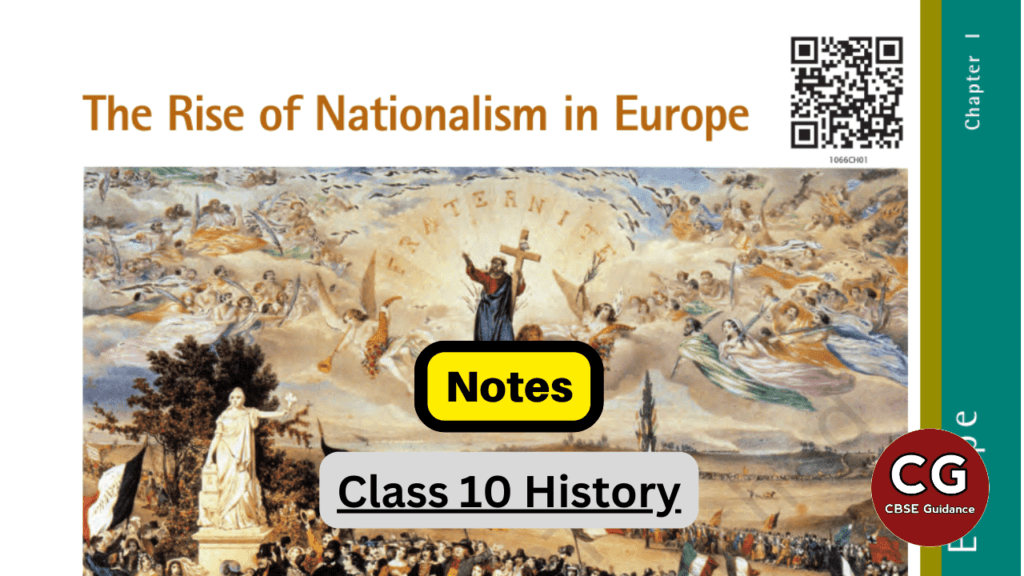
| Subject | Social Science (History) |
| Class | 10 |
| Board | CBSE |
| Chapter No. | 1 |
| Chapter Name | The Rise of Nationalism in Europe |
| Type | Notes |
| Session | 2024-25 |
| Weightage | 6 marks |
Table of Contents
Frederic Sorrieu’s Painting
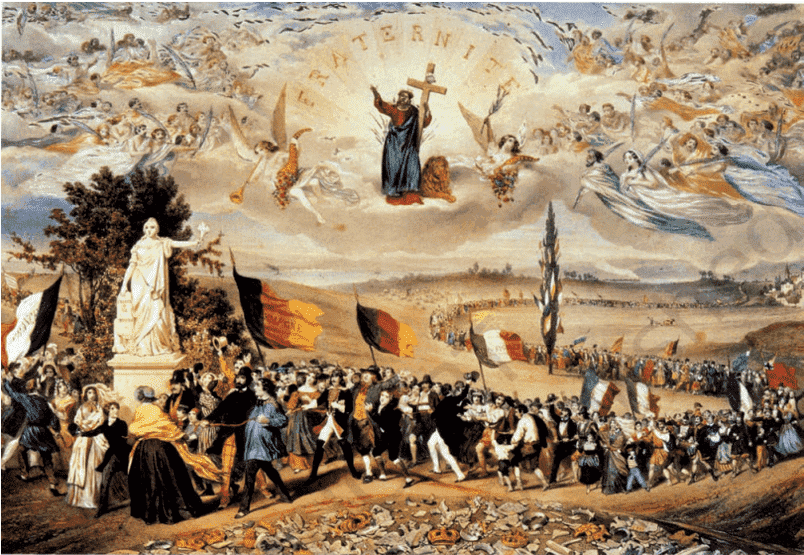
- In 1848, Frédéric Sorrieu, a French artist, prepared a series of four prints visualizing his dream of a world made up of ‘democratic and social Republics'.
- Artists of the time of the French Revolution personified Liberty as a female figure.
- In Sorrieu’s utopian vision, the peoples of the world are grouped as distinct nations, identified through their flags and national costume.
- Leading the procession are the United States and Switzerland, France, Germany, etc.
- From the heavens above, Christ, saints, and angels gaze upon the scene.
- They have been used by the artist to symbolize fraternity among the nations of the world.
The French Revolution and the Idea of the Nation
The measures and practices introduced by the French revolutionaries to create a sense of collective identity amongst the French people:
- The ideas of La Patrie (the fatherland) and Le Citoyen (the citizen) emphasized the notion of a united community enjoying equal rights under a constitution.
- A new French flag, the tricolor, was chosen to replace the former Royal Standard.
- The Estates General was elected by the body of active citizens and renamed the National Assembly.
- New hymns were composed, oaths taken and martyrs commemorated all in the name of the nation.
- A centralized administrative system was introduced and it formulated uniform laws for all citizens.
- Internal customs duties and dues were abolished and a uniform system of weights and measures was adopted.
- Regional dialects were discouraged and French became the common language of the nation.
The impact of Napoleonic reforms was:
- Through a return to monarchy, Napoleon destroyed democracy in France.
- The administrative field was made rational and efficient.
- The Civil Code of 1804 (Napoleonic Code) did away with all the privileges based on birth, established equality before the law, and secured the right to property.
- In the Dutch Republic, Switzerland, Italy, and Germany, Napoleon simplified the administrative divisions, abolished the feudal system, and freed the peasants from serfdom and manorial dues.
- In the towns, guild restrictions were removed.
- Transport and communication systems were improved.
Napoleon’s invasions were resented in several countries due to:
- Increased taxation
- Censorship
- Forced conscription into the French armies
The Making of Nationalism in Europe
The Aristocracy
- Socially and politically, a landed aristocracy was the dominant class on the continent.
- The members of this class were united by a common way of life.
- They owned estates in the countryside and also townhouses.
- They spoke French for purposes of diplomacy and in high society.
- Their families were often connected by ties of marriage.
- This powerful aristocracy was, however, numerically a small group. (the majority was the peasantry)
The New Middle Class
- In Western and parts of Central Europe, the growth of industrial production and trade meant the growth of towns and the emergence of commercial classes whose existence was based on production for the market.
- In the wake of industrialization, new social groups came into being: a working-class population and a middle class made up of industrialists, businessmen, and professionals.
- It was among the educated, liberal middle classes that ideas of national unity following the abolition of aristocratic privileges gained popularity.
Liberal Nationalism
- Liberalism in the early 19th century stood for freedom for the individual and equality for all before the law for the new middle classes.
- Politically, it emphasized the concept of government by consent.
- It stood for the end of autocracy and clerical privileges, a constitution, and a representative government through parliament.
Yet, equality before the law did not necessarily stand for universal suffrage. Men without property and all women were excluded from political rights.
- In the economic sphere, liberalism stood for the freedom of markets and the abolition of state-imposed restrictions on the movement of goods and capital.
In 1834, a customs union, or Zollverein was formed at the initiative of Prussia and joined by most of the German states. The union abolished tariff barriers and reduced the number of currencies from over thirty to two.
A New Conservatism after 1815
Conservatives believed that established, traditional institutions of state and society – like the monarchy, the Church, social hierarchies, property, and the family – should be preserved.
Conservatives realized, from the changes initiated by Napoleon, that modernization could in fact strengthen traditional institutions like the monarchy.
The Treaty of Vienna 1815
In 1815, representatives of the European powers – Britain, Russia, Prussia, and Austria – who had collectively defeated Napoleon, met at Vienna to draw up a settlement for Europe. The Congress was hosted by the Austrian Chancellor Duke Metternich.
The main provisions of the Treaty of Vienna held in 1815 were:
- The Bourbon dynasty which was destroyed during the French Revolution was restored to power.
- France lost the territories it had annexed under Napoleon.
- A series of states were set up on the boundaries of France to prevent French expansion in the future.
- Prussia was given new territories on its western frontiers, and Austria was given control of northern Italy.
- The German confederation of 39 states set up by Napoleon was left untouched.
- Russia was given part of Poland and Prussia was given part of Saxony.
- Monarchy was restored and a new conservative order was created in Europe.
Drawbacks:
- Conservative regimes set up in 1815 were autocratic.
- They did not tolerate criticism and dissent.
- Sought to curb activities that questioned the legitimacy of autocratic governments.
- Most of them imposed censorship laws to control what was said in newspapers, books, plays, and songs.
The Revolutionaries
Role of Giuseppe Mazzini as an Italian Revolutionary:
- Italian revolutionary Giuseppe Mazzini was born in Genoa in 1807. He became a member of the secret society of the Carbonari.
- He founded two underground societies, first Young Italy in Marseilles and Young Europe in Berne. Members of these societies were like-minded young men from Poland, France, Italy, and German states.
- Mazzini strongly believed that God had intended nations to be the natural units of mankind. So Italy had to be forged into a single unified republic within a wider alliance of nations.
- Following his model, secret societies were set up in Germany, France, Switzerland, and Poland.
- Mazzini’s relentless opposition to monarchy and his vision of democratic republics frightened the conservatives.
The Age of Revolutions: 1830-1848
- The first upheaval took place in France in July 1830.
- Metternich once remarked, ‘When France sneezes, the rest of Europe catches cold.’
Greek War of Independence
- An event that mobilized nationalist feelings among the educated elite across Europe was the Greek War of Independence.
- Greece had been part of the Ottoman Empire since the 15th century.
- Nationalists in Greece got support from other Greeks living in exile and also from many West Europeans who had sympathies for ancient Greek culture.
- Poets and artists lauded Greece as the cradle of European civilization.
- The English poet Lord Byron organized funds and later went to fight in the war.
- Finally, the Treaty of Constantinople of 1832 recognized Greece as an independent nation.
Romanticism
It was a cultural movement that sought to develop a particular form of nationalist sentiment in the following ways:
- Romantic artists and poets generally criticized the glorification of reason and science and focused on emotions, intuition, and mystical feelings.
- The German philosopher Johann Gottfried Herder claimed that through folk songs, folk poetry, and folk dances, the true spirit of the nation could be popularized.
- They gave emphasis on vernacular language and the collection of local folklore to recover an ancient national spirit and to carry the modern nationalist message to large audiences who were mostly illiterate.
The Role of Language in developing national sentiments in Europe
Poland had been partitioned at the end of the 18th century by the Great Powers – Russia, Prussia, and Austria. Even though it did not exist as an independent territory, nationalist feelings were kept alive through music and language.
- Karol Kurpinski, for example, celebrated the national struggle through his operas and music, turning folk dances like the polonaise and mazurka into nationalist symbols.
- When Russia occupied Poland, the Polish language was forced out of schools and Russian was imposed everywhere.
- Many members of the clergy in Poland began to use language as a weapon of national resistance. Polish was used for Church gatherings and all religious instruction.
- As a result, a large number of priests and bishops were put in jail or sent to Siberia by the Russian authorities as punishment for refusing to preach in Russian.
- The use of Polish came to be seen as a symbol of the struggle against Russian dominance.
Hunger, Hardship, and Popular Revolt
The 1830s were years of great economic hardship in Europe in the following ways:
- The first half of the 19th century saw an enormous increase in population which led to widespread unemployment.
- Population from rural areas migrated to the cities to live in overcrowded slums.
- Small producers in towns faced stiff competition from imports of cheap machine-made goods from England.
- In those regions of Europe where the aristocracy still enjoyed power, peasants struggled under the burden of feudal dues and obligations.
- The rise of food prices or a year of bad harvest led to widespread pauperism (poverty) in towns and countries.
1848 Events:
- Food shortages and widespread unemployment brought the population of Paris out on the roads.
- Barricades were erected and Louis Philippe was forced to flee.
- A National Assembly proclaimed a Republic, granted suffrage to all adult males above 21, and guaranteed the right to work.
- National workshops to provide employment were set up.
1848: The Revolution of the Liberals
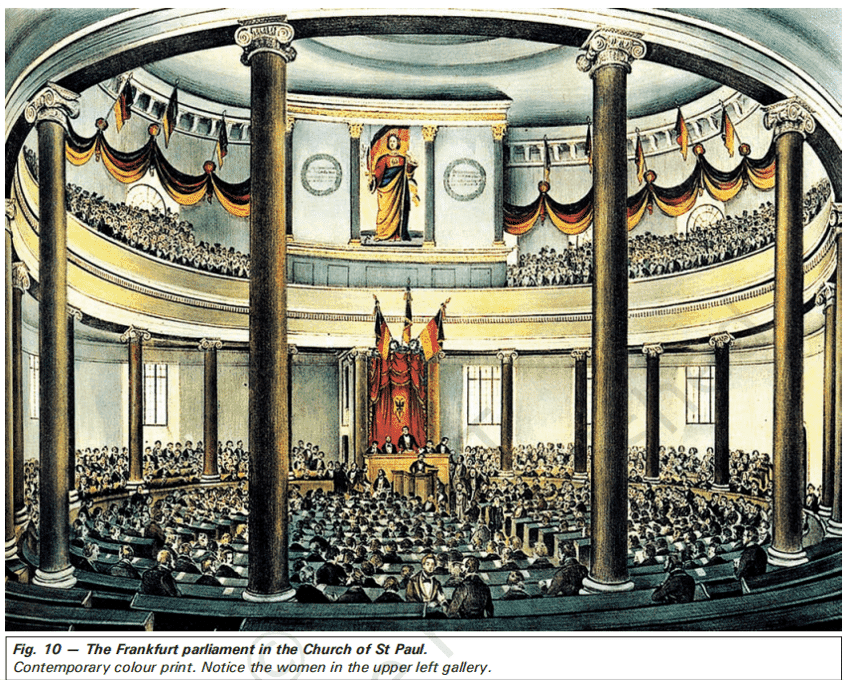
- Events of February 1848 in France had brought about the abdication of the monarch and a republic based on universal male suffrage had been proclaimed.
- In Germany, Italy, Poland, and the Austro-Hungarian Empire – men and women of the liberal middle classes combined their demands for constitutionalism with national unification.
- They took advantage of the growing popular unrest to push their demands for the creation of a nation-state on parliamentary principles – a constitution, freedom of the press, and freedom of association.
- In the German regions, a large number of political associations whose members were middle-class professionals, businessmen, and prosperous artisans came together in the city of Frankfurt and decided to vote for an all-German National Assembly.
- The middle classes resisted the demands of workers and artisans and consequently lost their support. In the end, troops were called in and the assembly was forced to disband.
- The issue of extending political rights to women was a controversial one within the liberal movement, in which large numbers of women had participated actively over the years.
- Women had formed their own political associations, founded newspapers, and taken part in political meetings and demonstrations.
The Role of Women in nationalist struggles
The issue of extending political rights to women was a controversial one within the liberal movement, in which large numbers of women had participated actively over the years. Women had formed their own political associations, founded newspapers, and taken part in political meetings and demonstrations. Despite this, they were denied voting rights during the election of the Assemble. When the Frankfurt parliament convened in the Church of St. Paul, women were admitted only as observers to stand in the visitors’ gallery.
The Making of Germany and Italy
The Making of Germany/ The Role of Otto Von Bismarck in the Making of Germany
- Prussia took on the leadership of the movement for national unification.
- Its chief minister, Otto Von Bismarck, was the architect of this process carried out with the help of the Prussian army and bureaucracy.
- Three wars over seven years – with Austria, Denmark, and France – ended in Prussian victory and completed the process of unification.
- In January 1871, the Prussian king, William I, was proclaimed German Emperor in a ceremony held at Versailles.
- On January 1871, an assembly comprising the princes of the German states, representatives of the army, and important Prussian ministers including the chief minister Otto von Bismarck gathered in the Hall of Mirrors in the Palace of Versailles to proclaim the new German Empire headed by Kaiser William I of Prussia.
The Making of Italy
- Italians were scattered over several dynastic states.
- Sardinia-Piedmont was ruled by an Italian princely house.
- The north was under Austrian Habsburgs, the center was ruled by the Pope and the southern regions were under the domination of the Bourbon kings of Spain.
- In the 1830s, Giuseppe Mazzini made efforts to unite Italy. He had also formed a secret society called Young Italy.
- The failure of revolutionary uprisings both in 1831 and 1848 meant that the mantle now fell on Sardinia-Piedmont under its ruler King Victor Emmanuel II to unify the Italian states through war.
- Chief Minister Cavour, through a tactful diplomatic alliance with France, succeeded in defeating the Austrian forces in 1859.
- Also, a large number of armed volunteers under Giuseppe Garibaldi joined them.
- In 1860, they marched into South Italy and the Kingdom of the Two Sicilies and succeeded in winning the support of the local peasants in order to drive out the Spanish rulers.
- In 1861 Victor Emmanuel II was proclaimed king of united Italy.
The Strange Case of Britain
- In Britain, the formation of a nation-state was a result of a long drawn-out process.
- There was no British nation prior to the 18th century.
- The primary identities of the people who inhabited the British Isles were ethnic ones such as English, Welsh, Scot, or Irish.
- Later the English Parliament, which had seized power from the monarchy in 1688 at the end of a protracted conflict, was the instrument through which a nation-state with England at its center came to be forged.
- The Act of Union (1707) between England and Scotland that resulted in the formation of the ‘United Kingdom of Great Britain’ meant, in effect, that England was able to impose its influence on Scotland.
- The British parliament was henceforth dominated by its English members.
- The growth of a British identity meant that Scotland’s distinctive culture and political institutions were systematically suppressed.
- Ireland suffered a similar fate. It was a country deeply divided between Catholics and Protestants.
- The English helped the Protestants of Ireland to establish their dominance over a largely Catholic country.
- Catholic revolts against British dominance were suppressed.
- After a failed revolt led by Wolfe Tone and his United Irishmen (1798), Ireland was forcibly incorporated into the United Kingdom in 1801.
Visualising the Nation
- Artists in the 18th and 19th centuries personified the nation. They represented a country as if it were a person.
- Artists portrayed nations as female figures.
- Artists used the female allegory to portray ideas such as liberty, justice, and the republic.
- In France, the female allegory was christened Marianne, a popular Christian name, which underlined the idea of a people’s nation.
- Her characteristics were drawn from those of Liberty and the Republic – the red cap, the tricolor, the cockade.
- Statues of Marianne were erected in public squares to remind the public of the national symbol of unity and to persuade them to identify with it.
- Marianne's images were marked on coins and stamps.
- Germania became the allegory of the German nation. She wears a crown of oak leaves, as the German oak stands for heroism.
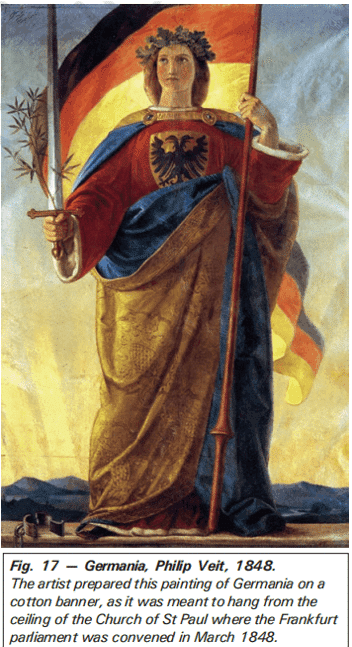
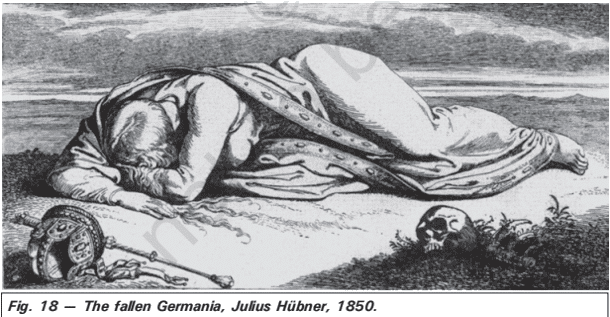
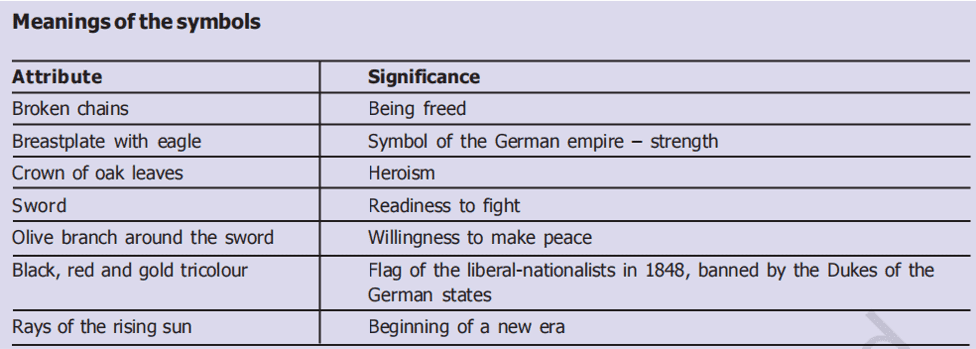
Nationalism and Imperialism
The growth of nationalist tensions in the Balkan region before the First World War
- The Balkan was a region of geographical and ethnic variations comprising modern-day Romania, Bulgaria, Albania, Greece, Macedonia, Croatia, Bosnia-Herzegovina Slovenia, Serbia, and Montenegro. The inhabitants were called Slavs.
- A large part of the Balkans was under the control of the Ottoman Empire while some other parts were under the control of Russia and Austria causing a complex problem.
- The spread of ideas of Romantic nationalism in the Balkans together with the disintegration of the Ottoman Empire made the region very explosive.
- Different Slavic nationalists struggled to define their identities.
- The Balkan region became a region of intense conflict over the expansion of territory.
- At the same time, the great European Powers – Russia, Germany, England, and Austro-Hungary were keen on taking the control of the Balkan region, since it was important from the trade point of view.
- This led to a series of wars in the region and finally became the cause of the First World War.
The idealistic liberal-democratic sentiment of nationalism in the first half of the 19th century became a narrow creed with limited ends
- During this period, nationalist groups became increasingly intolerant of each other and were ever-ready to go to war.
- Major European powers manipulated the nationalist aspirations to further their own imperialist aims.
- The most serious source of nationalist tension in Europe after 1871 was the area called the Balkans.
- The idea of romantic nationalism in the Balkans together with the disintegration of the Ottoman Empire made this region very explosive.
- One by one, European nationalities broke away from their control and declared independence.
- The Balkan people based their claims for independence or political rights on nationality and used history to prove that they had once been independent but had subsequently been subjugated by a foreign power.
- As the different Slavic nationalities struggled to define their identity and independence, the Balkan area became an area of intense conflict.
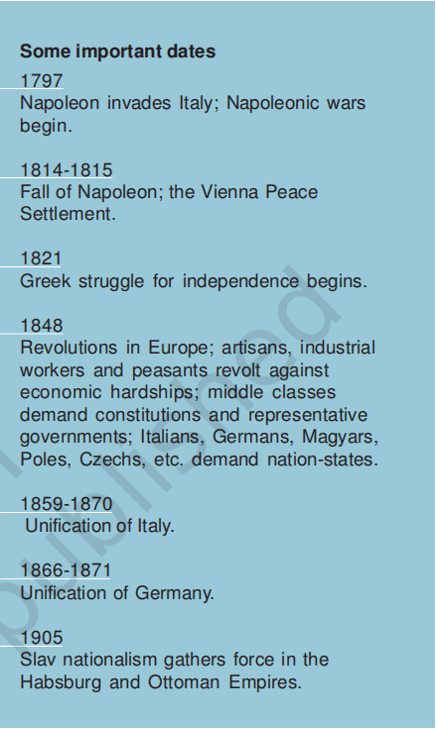
| Key Word | Meaning |
| Absolutist | Literally, a government or system of rule that has no restraints on the power exercised. In history, the term refers to a form of monarchical government that was centralised, militarised and repressive. |
| Utopian | A vision of a society that is so ideal that it is unlikely to actually exist. |
| Plebiscite | A direct vote by which all the people of a region are asked to accept or reject a proposal. |
| Suffrage | The right to vote. |
| Conservatism | A political philosophy that stressed the importance of tradition, established institutions and customs, and preferred gradual development to quick change |
| Feminist | Awareness of women’s rights and interests based on the belief of the social, economic and political equality of the genders |
| Ethnic | Relates to a common racial, tribal, or cultural origin or background that a community identifies with or claims |
| Allegory | When an abstract idea (for instance, greed, envy, freedom, liberty) is expressed through a person or a thing. An allegorical story has two meanings, one literal and one symbolic |
| MUST Read: The Rise of Nationalism in Europe Class 10 Important Questions and Answers to get an idea of the type of questions that can be asked from this chapter. |
| Must Read: Nationalism in India Class 10 Notes |
| You Might Also Like: CBSE Class 10 Notes CBSE Class 10 Important Questions and Answers |
Hope you liked these notes. Please share this with your friends and do comment if you have any doubts/suggestions to share.
Sir please upload revision notes for geography 2nd chapter
Okay!
Sir please short note upload kar do jisa hmm jaldi revision kar saka
Sir.. please ye sare notes and questions answers sab pdf form me milega kya?
How to Download PDF from CBSE Guidance Website
https://youtu.be/zjocgf0LzUM
Sir pls add Neet and JEE syllabus too 🙏